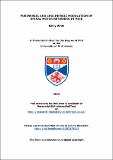Files in this item
Purinergic and cholinergic modulation of spinal motor networks in mice
Item metadata
| dc.contributor.advisor | Miles, Gareth Brian | |
| dc.contributor.author | Witts, Emily | |
| dc.coverage.spatial | 138 p. | en_US |
| dc.date.accessioned | 2016-03-30T09:16:23Z | |
| dc.date.available | 2016-03-30T09:16:23Z | |
| dc.date.issued | 2016-06-21 | |
| dc.identifier | uk.bl.ethos.682787 | |
| dc.identifier.uri | https://hdl.handle.net/10023/8513 | |
| dc.description.abstract | Neuromodulation allows flexibility within networks of neurons controlling rhythmic motor behaviours. This thesis explores how purinergic and cholinergic neuromodulation contributes to the functioning of spinal motor networks in mice. Purinergic modulation in the spinal cord was investigated using neonatal mouse in vitro spinal cord preparations in which locomotor-related bursts of activity were pharmacologically induced. Ventral root recordings from these preparations showed that glia release ATP, which is broken down to adenosine and binds to A1 adenosine receptors to reduce the frequency of locomotor-related bursts. Whole-cell patch-clamp recordings showed that adenosine opens leak potassium channels in ventral horn interneurons, leading to general network inhibition. Interestingly, although adenosine reduces synaptic inputs in interneurons and motoneurons, interneurons show a reversible hyperpolarisation and reduction of miniature postsynaptic currents (mPSCs) in response to adenosine, while motoneurons show a reversible depolarisation and no change in mPSCs. It was therefore concluded that adenosine opens leak potassium channels in ventral horn interneurons which reduces the speed of locomotor-related output from the whole network. However, motoneuron activity is prevented from falling so far as to cause muscle contraction to cease. Cholinergic modulation of mouse spinal motor networks was also investigated. Pitx2+ cells, known to be the source of cholinergic C-bouton inputs to motoneurons, were selectively transfected with channelrhodopsin and light was used to activate the Pitx2+ cell population. Pitx2+ cell activation was found to reduce rheobase and range of firing in small numbers of spinal motoneurons. The role of Pitx2+ cells in behaviour was also investigated by testing adult mice before and after Pitx2+ cell ablation. No difference in performance was observed in reaching or ladder walking tasks. It therefore seems likely that activation of Pitx2+ cells modulates motoneurons via C bouton synapses, but this modulation is task-dependent and is not critical for goal-directed movements requiring fine motor control. | en_US |
| dc.language.iso | en | en_US |
| dc.publisher | University of St Andrews | |
| dc.subject | Motor control | en_US |
| dc.subject | Spinal cord | en_US |
| dc.subject.lcc | QP371.W5 | |
| dc.subject.lcsh | Motor control | en_UK |
| dc.subject.lcsh | Motor neurons | en_UK |
| dc.subject.lcsh | Spinal cord | en_UK |
| dc.subject.lcsh | Mice--Physiology | en_UK |
| dc.title | Purinergic and cholinergic modulation of spinal motor networks in mice | en_US |
| dc.type | Thesis | en_US |
| dc.type.qualificationlevel | Doctoral | en_US |
| dc.type.qualificationname | PhD Doctor of Philosophy | en_US |
| dc.publisher.institution | The University of St Andrews | en_US |
This item appears in the following Collection(s)
Items in the St Andrews Research Repository are protected by copyright, with all rights reserved, unless otherwise indicated.

